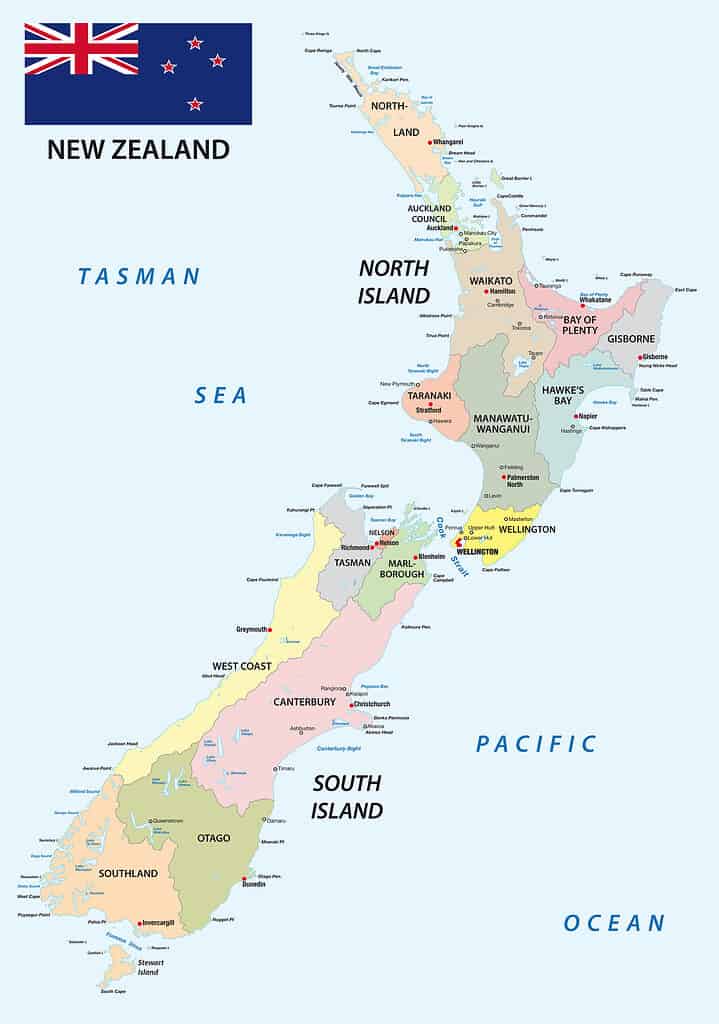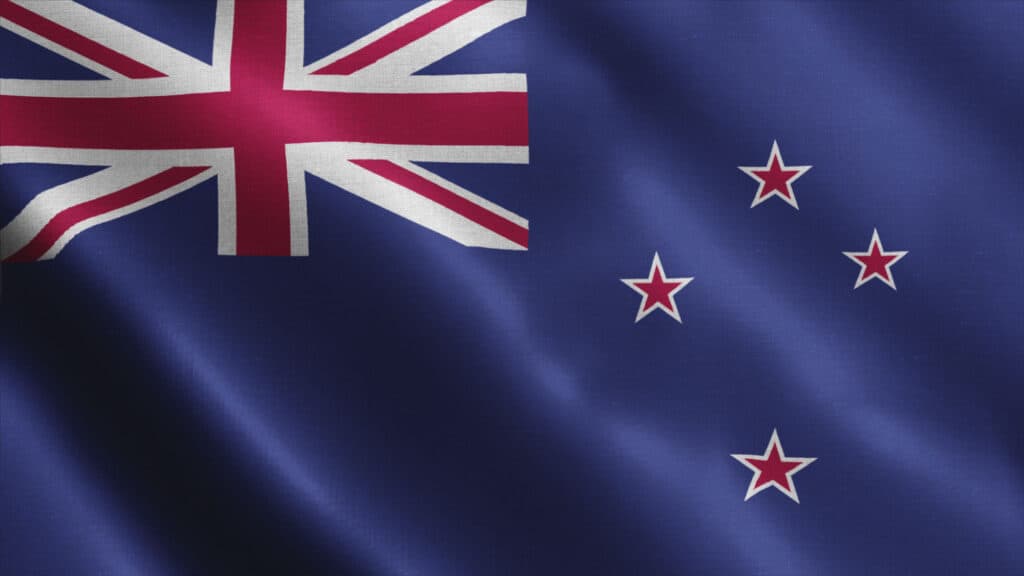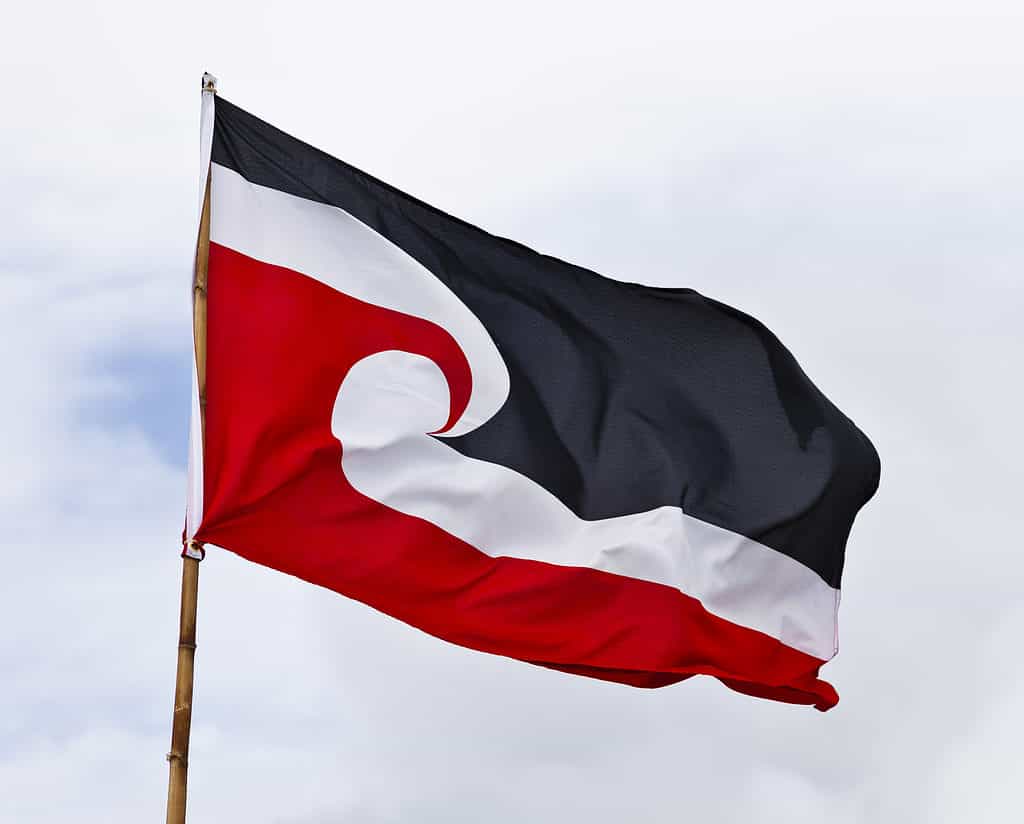For centuries flags have been flown all around the world, consisting of various combinations of colors, symbols, and shapes. They can be used to represent countries, states, political parties, and even different cultures. They can also provide a fascinating insight into the past. However, New Zealand is one of a few places that also features another country’s flag within their own – the British flag in this case. Read on to discover everything you need to know about the flag of New Zealand – including it’s history and what it represents. We’ll also learn about the former national flags, and the current Māori flag too.
About New Zealand
New Zealand is an island country which consists of two main islands – North Island and South Island – and around 700 smaller islands. New Zealand was one of the last areas to be settled by humans, with Polynesians arriving between 1280 and 1350. The Māori culture was developed by these Polynesians and is now an important and distinctive culture in New Zealand. The first European to visit New Zealand was the Dutch explorer, Abel Tasman in 1642. However, it was only from the late 1700’s that European presence increased in the area.
Although New Zealand was initially part of the Colony of New South Wales as part of Australia in 1840, by 1841 it became the Colony of New Zealand which was a colony of the UK. The Colony of New Zealand lasted until 1907, upon which it became the Dominion of New Zealand – giving it a higher level of self-government. New Zealand eventually gained full independence from Britain in 1947.

New Zealand consists of two main islands – North Island and South Island and around 700 smaller islands.
©iStock.com/Rainer Lesniewski
The Flag of the United Tribes of New Zealand
New Zealand didn’t have a flag until 1834. Its first official flag is known as the flag of the United Tribes of New Zealand. It is also known as Te Whakaputanga o te rangatiratanga o Niu Tirene or Te Kara in Māori. The flag consists of the St. George’s cross with another St. George’s cross on a blue field in the canton. Each quarter of the second cross has a white eight-pointed star in it. The flag was initially designed by Henry Williams in 1923 as the flag of the New Zealand Church Missionary Society. It remained in use as the society flag until 1833.
In 1834 three flag designs – including the Church Missionary Flag – were put forward for a vote that was held by the Māori chiefs of the United Tribes of New Zealand. Henry Williams’ flag won the vote and it was adopted as the first New Zealand flag. The flag remained in use as the national flag until 1940 when the British Union Jack flag was adopted following the signing of the Treaty of Waitangi. The Treaty of Waitangi was a land agreement between Britain and 500 Māoris.
Although the Union Jack was adopted as the national flag until 1867 the Te Kara flag didn’t go out of use. Many Māoris were unhappy with the treaty and did not want to use the British flag. Therefore, they continued to use the Te Kara flag. In fact, it still remains in use today as a Māori flag.
History of the Flag of New Zealand
The current flag of New Zealand – also known as the New Zealand Ensign – consists of a dark blue field with the British Union Jack in the canton. It also features four red stars outlined in white. Although the flag was not officially adopted until 1902, it was the de facto national flag from 1869.
The current flag is based on the flag that was used between 1867 and 1869. The origin of both flags comes from the UK’s Colonial Defence Act of 1865. This act stated that all colonial ships must fly the Blue Ensign flag – a blue field with the Union Jack in the canton – with a distinguishing badge of the colony. However, as New Zealand did not have an official emblem at the time they initially flew the Blue Ensign without any colonial badge. As a result, two New Zealand ships were eventully reprimanded for not flying a flag that distinguished them appropriately.
Following this incident New Zealand decided that it needed to appoint an appropriate flag to meet the requirements of the bill. Although several designs were put forward the one that was settled on consisted simply of the Blue Ensign with an “NZ” abbreviation in the corner. This version was used for two years before it was decided to adopt a new, more distinguishing design.
The current flag was designed by Albert Hastings Markham. It consists of the four red stars instead of the “NZ” abbreviation – which had actually been one of the designs considered two years earlier.

The current flag of New Zealand consists of a dark blue field with the British Union Jack in the canton.
©iStock.com/Rawf8
Symbolism and Meaning
There are two main aspects to the flag of New Zealand – the Union Jack and the four stars. First of all, the Union Jack represents New Zealand’s history as a colony of the UK.
Secondly, the four red stars represent the Southern Cross – also known as the constellation Crux. The Southern Cross consists of four stars in a cross shape. It is visible at the southern end of the Milky Way. All four stars are incredibly bright and have an apparent magnitude of more than 2.8. The Southern Cross is one of the most distinctive sights in the southern hemisphere sky. It has been a symbol of the colonies in the southern hemisphere for hundreds of years.
The Southern Cross is also significant in Māori mythology and is known as Māhutonga. The story goes that Māhutonga is an opening in the Milky Way (Te Ikaroa) through which storm winds escape.

The four red stars in the flag of New Zealand represent the Southern Cross constellation.
©Tatohra/Shutterstock.com
The National Māori Flag
Although the Te Kara flag is still used by Māoris, the Tino Rangatiratanga flag is the national Māori flag and was adopted in 2009. The flag features a koru – a common Māori design – in the national colors of New Zealand.
The koru design represents hope for the future and is often used on tattoos. However, the national colors all have a particular reference to the creation story in Māori mythology. Black (Te Korekore) represents potential being and red (Te Whai Ao) means coming into being. Finally, white (Te Ao Mārama) represents the realm of being and light. White also references Aotearoa which is the Māori name for New Zealand and means “land of the long white cloud”.
In addition to the Tino Rangatiratanga flag, Māoris also use the Red Ensign. This is a version of the current New Zealand flag but on a red field. This flag was originally intended for use by merchant ships, but Māoris prefer this version to the official New Zealand flag because of its red color. Therefore, it is allowed to be used on land only at Māori events and in Māori areas.

The Tino Rangatiratanga
flag is the national Māori flag, which was adopted in 2009, representing hope for the future.
©Jamie Farrant/Shutterstock.com
New Zealand Flag Debate
Several times over the years the question as to whether New Zealand needs a new flag has been raised. The main criticism of the current flag is that it is too similar to the flag of Australia. Also, some people feel that it does not acknowledge the country’s Māori heritage.
In 2015 and 2016 a series of referendums were held to ask the people of New Zealand to choose their national flag. After a shortlist of four designs, the the final vote was between the current national flag and a flag known as the black, white, and blue silver fern flag. This design incorporates the silver fern flag design (often used as an unofficial symbol of New Zealand) and the southern cross from the current flag. However, the public decided to keep the current national flag with a vote 56.6% in favor.
For now the current flag is unchanged, but whether the question is raised again in the future remains to be seen.
Up Next
- Every Flag in the World: Photos, History, and More
- The Flag of Australia: History, Meaning, and Symbolism
- The Flag of Fiji: History, Meaning, and Symbolism
The photo featured at the top of this post is © iStock.com/LysenkoAlexander
Thank you for reading! Have some feedback for us? Contact the AZ Animals editorial team.






